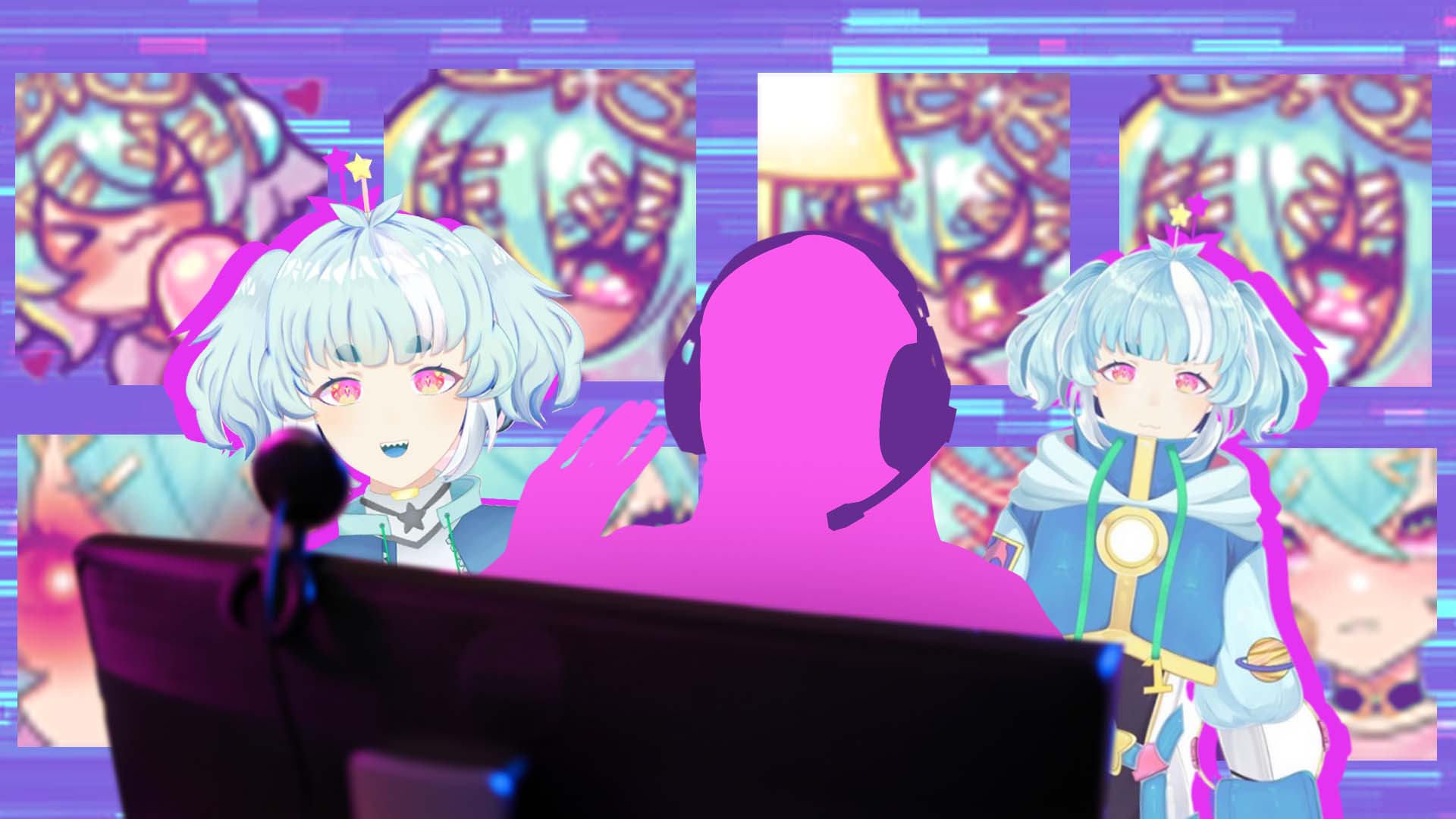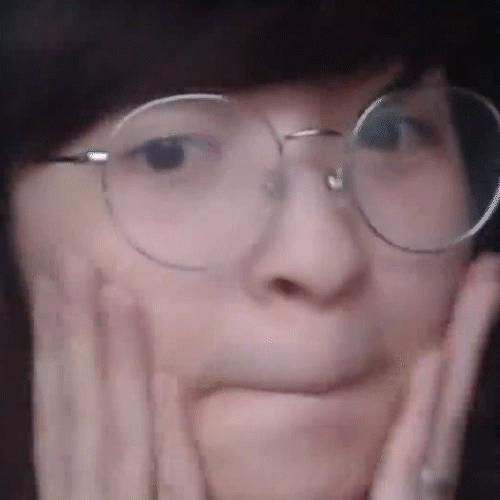DISCLAIMER: All views and opinions expressed in this post are solely those of the contributor/s and do not represent those of InqPOP! and INQUIRER.net. The InqPOP! staff assumes no liability for any error in the content of this material. Got something you want to share to the world? Get a chance to publish your awesome creations and share it to the world through our InqPOP! Creator Community program. Send us your stories, videos, photos, fan fic, and even fan art at pop@inquirer.net
For more details, read the POP! Creators FAQ page.
________Streamer. That word brings up more than just party favors to Millennials and Gen Z’ers. A streamer is a person who shares a live video of themselves to people all over the world. Odds are if you’re reading this, you’ve probably seen a stream. You have probably seen a highlight or a clip from a stream. Perhaps you have seen a video of a person screaming in delight after winning in a video game or laughing their head off seeing their friend make a mistake in chess. Beyond those highlights, however, is a world that you may be surprised to find. A thriving community of fans, celebrities, and everything in between, creates an ecosystem around these streaming figures.
Watching a stream is an experience that is unlike any other. The biggest factor is interactivity. You not only watch streams, but you participate through a real-time chat feature, chatting with fellow viewers and the streamer themselves. This real-time chatting is what makes streaming truly special. Watching someone play a video game must sound, to an outsider, like the most boring thing ever. But when you can actually talk to the person behind the screen and affect what they do, it turns into a unique experience. The chat is a living, breathing organism. It affects everything in a stream. The streamer talks to chat, plays to chat, and lives through chat. They are the lifeblood of the stream.
With the COVID-19 pandemic having forced people to stay at home, many used technology to connect with others and continue their lives. We have talked to a psychologist, a few streamers, and their fans about the relationships we have online with people we have never met in real life. What kind of issues are there in this relationship? How healthy is it? What does this mean for the future? Let’s start with the first question we ask ourselves about the whole thing.
Why?
Hello World
To help answer this question, we talked to 3 streamers and some fans about this phenomenon. Firstly, we talked to two streamers who did not show their real face or use their real names and instead used a persona to talk to their audience. The first streamer was named Monnoe* (pronounced mono), an alien from area 51, and the second was Xelafina*, a moth fairy. However, we would like to start with a more straightforward face.
Hooleeyah* is a streamer on twitch with over 7000 followers. She is a Filipino girl with circular glasses whose face and voice is seen and heard by hundreds of viewers as she tinkers with her keyboards, plays video games, and sometimes just chats, all for her audience.
Hooleeyah almost did not want to show her face when we were interviewing her, but as timid as she seemed during the interview, her streams always exude a certain kind of confidence and warmth that her followers keep coming back to. Her username on Twitch resembles her real name: Julia, at which she gladly and willingly spoke without confidentiality. Unlike other streamers who hide behind their avatars, Julia keeps things out in the open.
“When you show your face, it’s something people can relate to a lot,” she shared.
While the other two streamers prefer to keep things a little private, it is not necessarily for anonymity purposes. Xelafina*, or Xela for short, found that appearing through an avatar was the most convenient way for her. Like most of the other streamers who have their traditional face cam with their ornate setup and streamer face on, Xela admitted that she did not always have the energy for that.
“Sometimes I just want to start streaming kahit naka pajamas lang.” She laughed talking about it.
(Even if I’m just in my pajamas.)
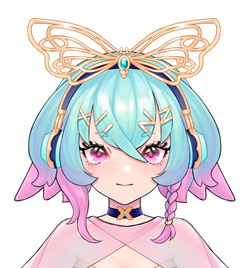
Similar to Xela, Monnoe also shared the same sentiments. It’s quite difficult to always show up with makeup on, and for Monnoe, having to get ready would require her a whole lot of patience. Besides, with the avatar that she has, who would have known that she would be flaunting her own drawing? In her words, “Who doesn’t want to be a f****** anime girl?” Their unusual names, which are the kind of usernames used by both streamers and fans, help keep their real identities safe and allow them to be more relaxed than they would be in real life.
Hiding behind these anime avatars is not simply arbitrary as it is a big part of the streaming community. They are called VTubers or “virtual YouTubers” which is a bit of a misnomer as the two that we spoke to stream on Twitch. These streamers take a persona of a specific avatar and present themselves as such. Created out of a digital mask, their avatar moves along with their face using face-tracking technology. They change in more than just their appearance, as this persona allows them to act differently than how they do in real life.
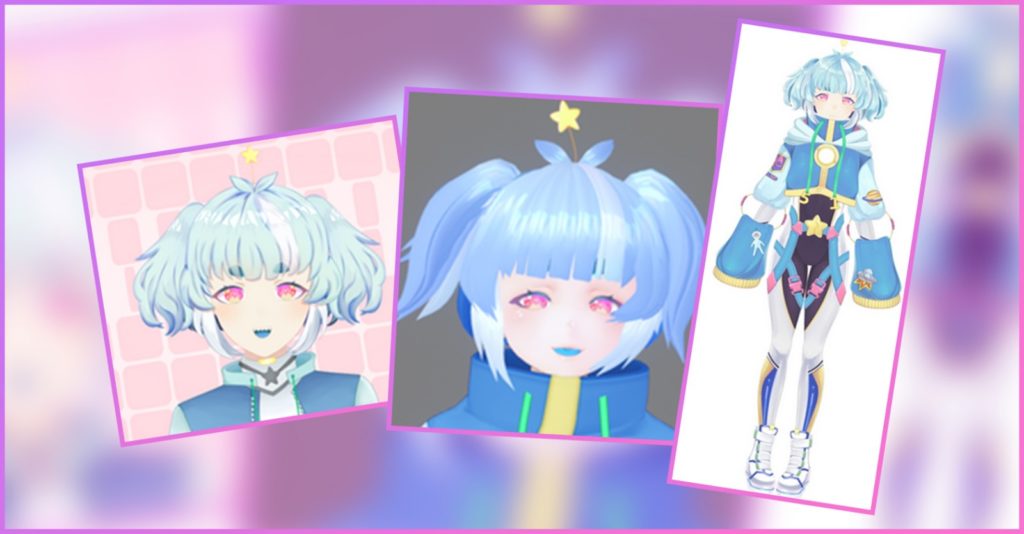
The streamers we interviewed are known to be “variety streamers” with a wide array of topics they share including art, games, music, singing, chatting, keyboard building, and many more. Variety is the spice of life, and though there exist more focused streamers, these three’s interests are simply too varied to keep to one thing.
Taking the plunge
While these streamers all have a lot of variety, how each of them got into streaming varied. Julia loved watching YouTube, particularly enjoyed watching highlights of LilyPichu, a Twitch variety streamer mostly showcasing games and art. After graduating from college, she did not pressure herself to pursue a job just yet, and since gaming was on her radar, she realized that she could spare some time to try it out. It has been two years since she started streaming in her parent’s living room, barely making through with the noise and the WiFi connection reaching her laptop. Now, she has her own set up in her own place with almost 8,000 followers on Twitch.
The experience was unlike any other as she also intends to pursue streaming full-time. “I can’t imagine not streaming anymore like it’s pretty much a big part of my life now,” Julia said with a smile plastered on her face.
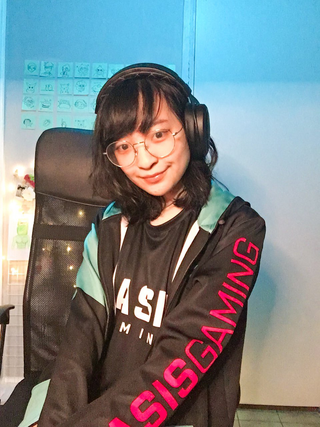
Dealing with social anxiety could take a toll on one’s socialization and confidence, and Xela understood that if she did not challenge herself to breakthrough, she would remain stuck and unable to maximize her passion for art. Xela’s beguiling interest in streaming goes way back to 2013, but it was not as popular as it is today. At the onset of the pandemic and with the streaming community booming, Xela strived to start her own stream despite her struggle with anxiety. In fact, it became leverage to build her confidence.
When asked why Monnoe started streaming her response was as paradoxical as her reaction. Surrounded by her streamer friends, loud and sure, she said “I am really, really, freaking lonely.” However, another reason for her interest in streaming stemmed from her love of virtual streamer Kanae who she said was an “astounding player of Apex Legends” (a first-person shooter battle royale game.) Besides this, a streamer friend named Lamienthana with whom she knew in real life influenced her to start streaming. The reasons to get into streaming vary, but overall they come down to passion for things, connection with others, self-expression, or just to have fun. After all, when you’re behind a screen anything goes.
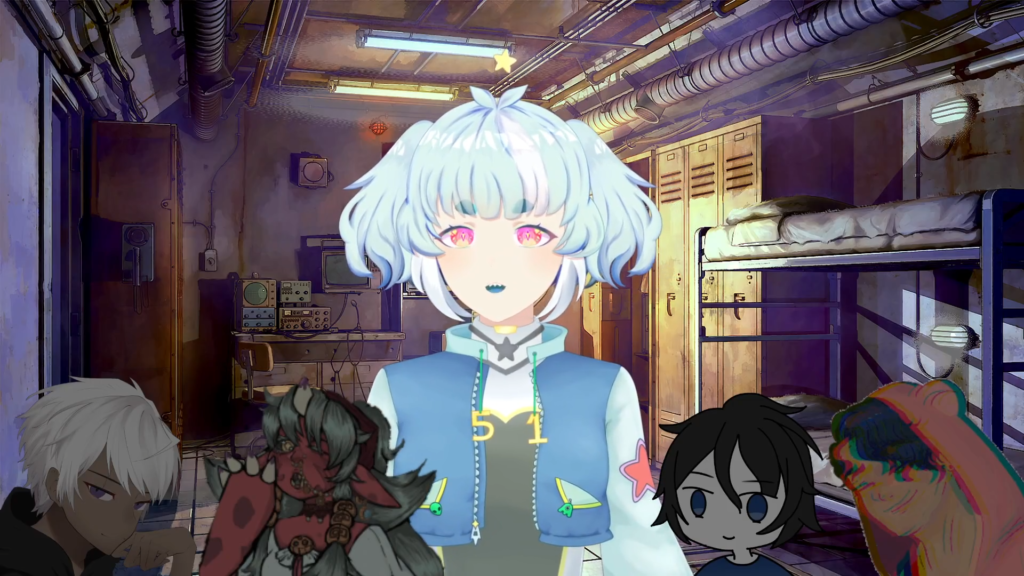
A Tale as Old as Time
As new as it appears, especially since the pandemic made streaming more popular, it has, in fact, been around since the early 1990s. The first live stream video was aired in 1993 when the band Severe Tire Damage held a concert online. Afterward, live streaming increasingly pervaded the internet, and it had become an activity for leisure and entertainment. With the launch of YouTube in 2005 and YouTube Live in 2011, people had an avenue to showcase themselves to the world. Various streaming platforms followed after—with Netflix airing shows and movies, streaming’s appeal had an increasing impact not just on how it broadcasts real-time but also in creating cultures for various spheres.

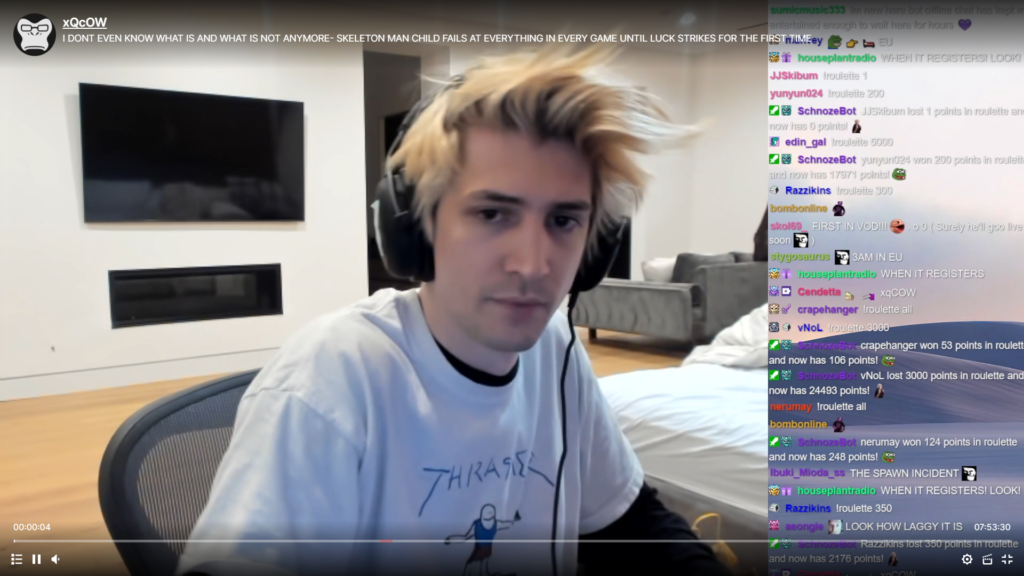
The gaming community pivoted on the launch of Twitch. Acquired by Amazon in August 2014, Twitch had gradually gained popularity and has become a consequential tool in the culture of gaming. This platform allows its streamers to post a live feed of their gaming activities while simultaneously interacting with their fans. Over the years, Twitch has not solely catered to gamers and its enthusiasts as it cultivates a community of streamers who share anything under the sun. This is the reason why Julia streams her ardent passion for building keyboards and the same goes for Xela’s process of creating art. Twitch has become a platform for a plethora of topics. You are sure to find something within your interest.
But streaming games is not limited to this platform as Facebook’s gaming community has been on the rise. Having its own place in the site called Facebook Gaming, streamers have the opportunity to make themselves known and make money out of it. While it has a similar experience and model to that of Twitch, with Facebook’s general popularity, streamers can easily get a following. For a less game-focused and more local experience, the app Kumu has Filipino streamers both big and small that cover mostly general topics such as music and living. Suffice to say, if you want to see someone do something live you can find it with ease.
We conducted a survey on streamer fans regarding their behavior toward watching streams online. The pandemic plays a huge role in stream-watching as many of them started during the pandemic. It was found that out of 43 participants, the majority of them watch streams a few times a month while watching every single day comes second. Twitch is the most popular platform they watch their streams from. Facebook Gaming and YouTube Gaming followed with Tiktok, Kumu, Bigo, and Uplive as other streaming platforms.
It’s interesting to see that while more than half of them actively participate in streams (eg. engage in chats, buy merchandise, donate), there are a handful of those who are passively watching. This is a factor to consider since chatting with streamers is such a significant part of streaming. There are still those who are simply just watching.
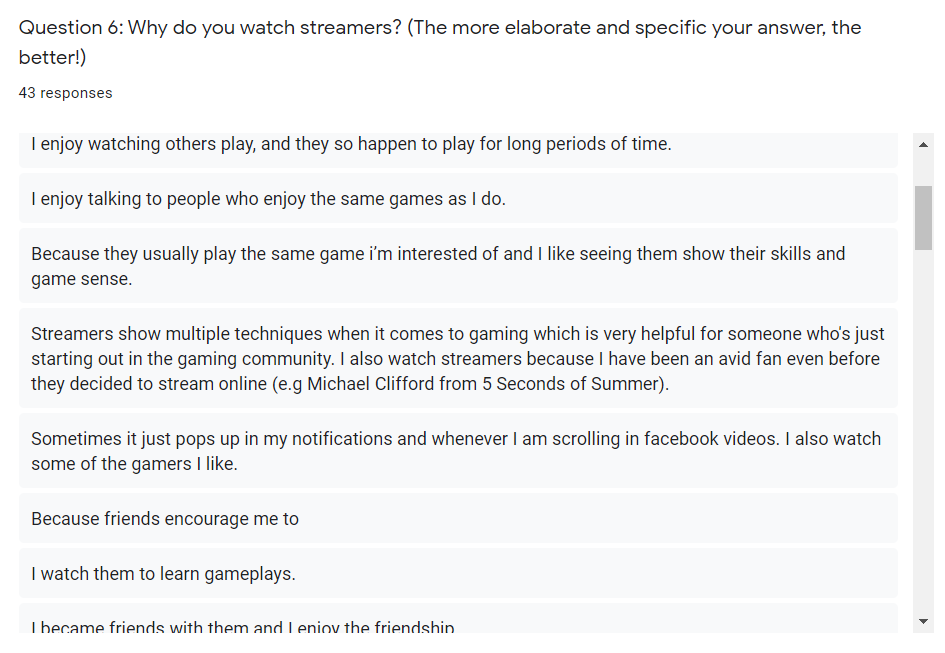
Streaming is mostly for entertainment purposes, especially now in the pandemic, since many are in isolation. Socialization also comes into play as many of them have made friends just through chatting and engaging with each other. Others take streams as means to learn gameplay as well as improve their skills in drawing and art. While it has many positive effects, streaming also poses negative effects, especially those who find themselves constantly seeking it. Ironically, a handful of these attention seekers find the community they are situated in to be toxic.
Streaming is a completely different beast from vlogging and video making. At first, Julia tried vlogging, but it got tiring over time. Xela couldn’t find the energy to go through the process of filming, editing, and uploading. Streaming live is much simpler: you put yourself on camera live and you interact with your audiences, needing minimal effort to tweak some of its overlays. Interacting with the fans in real-time is intimate and personal. Monnoe needed a sense of belonging, and she found it in her community. Friends, she would call them.
It’s not only the fans that streamers get to interact with but other streamers as well. While there are innumerable streamers with the same content, the community fosters collaboration. Monnoe’s community is a great example as she likes to make each and every one of her fans feel at home. With some of her friends’ being streamers themselves, she makes it a point to support and collaborate with them. For the most part, it’s a healthy community that’s why people come back, but as Julia and Xela pointed out, there are people who come and go in their streams; not everyone is a follower, not everyone is a fan. They understand that in order for them to build community, a part of their lives needs to be shared, even to the extent of opening up about their personal lives.
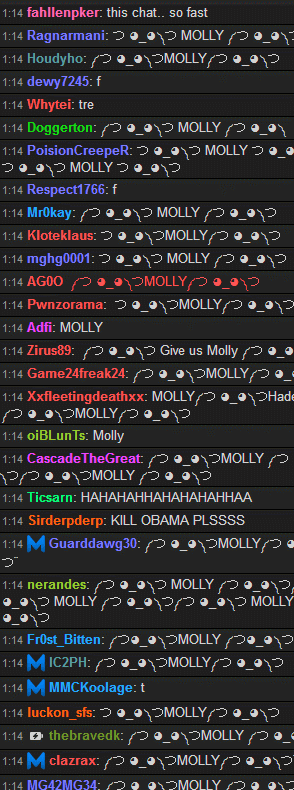
Blurring the lines between a streamer and a fan can get tricky when this happens. Sometimes when a fan gets too comfortable, they overstep boundaries, or as Xela called it, “trauma dumping.” For instance, a fan would share their personal problems, and somehow there is an expectation from the streamer to offer some sort of comfort or advice. And all these are shared virtually with no full knowledge of who is on the other end of the screen. All the streamer gets to see is the username of the fan in the chat. Xela had encountered rare cases, and she had to learn it the hard way, as she shared, “It’s important to set some sort of boundaries.” Now, she would immediately block people who would try to give at least a hint of overstepping her personal space.
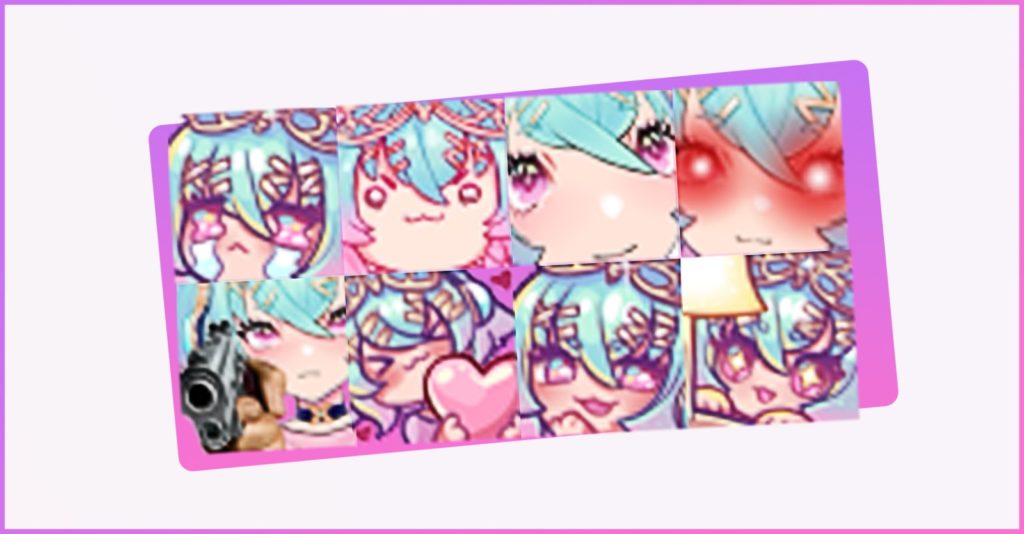
Here is a medley of streamers to give you a taste of a multi-hour stream in 3.5 Minutes. Featuring Valorant Semi-Pro Typhoid and Variety Streamer Nadilia alongside the 3 streamers we profiled.

Now you see me…
This kind of relationship between a fan and a streamer is considered parasocial. A “Parasocial Relationship” is a one-sided relationship with a spectrum ranging from fictional characters in books or movies to media personas in television or social media. Whether the relationship is real or not is in question due to the unorthodox nature of the connection. Coined by anthropologist Donald Horton and sociologist R. Richard Wohl in 1956, this phenomenon was observed in the advent of television when people had come face to face with TV personalities without leaving their homes. Particularly, the observation came from talk shows where the host engaged with the audience as though they were present in the studio.
The relationship intensifies through constant exposure. The more a person invests in exerting time and interest with the persona, the more they are likely to be fond of them. Parasocial relationships are unreciprocated in nature as personas do not have any knowledge of the existence of the other. With technology’s rapid evolution, however, the phenomenon is affected through the change in mediums. Now, information is traveling in a continuum. There are many avenues through which you can acquire it, may it be in social media, mobile apps, and websites. The opportunity for reciprocity is highly probable. For instance, a celebrity has the choice to reply to a comment on Instagram, and fans have the means to message them through direct messages. The line is thin with a single response to cross it.
In streaming, chatting with followers is a vital part of the stream. If you relentlessly chat, chances are you can get mentioned. It may depend, however, on the popularity of the streamer. Julia, despite having quite a huge following, made it a point to acknowledge the people that come in, even at times literally mentioning every person that comes into the chat. It goes to show that she takes interest in what her fans had to say. The degree of parasocial then leans on the kind of dynamic the platform offers and depends on the popularity of the persona.
While this relationship seems trivial, it offers many benefits. Workroom Sciences Dallas Research Associate Dr. Carol Jarzyna remarked that these relationships begin in our minds and stressed that these have positive effects. “Although it’s fictional, there are psychological benefits from it,” she said.
The COVID-19 pandemic has forced people to stay in their homes with nothing but technology to entertain themselves. A Netflix show could curb loneliness. A personal message would keep ties intact. The internet has become everyone’s companion in such a precarious time. For homebodies and introverts, it’s much easier to adapt to the situation as socializing is in itself already challenging, so hiding under their sheets with their favorite movie sure comes in handy. But the pandemic has not only put your physical health at risk but also your mental health. With the uncertainty it brings, anxiety and depression have drastically increased. While of course, parasocial relationships should not be the antidote to a decline in mental health, they could offer temporary relief. Dr. Jarzyna even emphasized that parasocial relationships could never replace real-life relationships.
The community that is cultivated on Twitch has traversed through the platform as streamers continue their interactions with their fans in other sites such as Discord, an instant messaging and digital distribution platform. This allows them to post updates and announcements about their live schedules and other shenanigans.
Check out our podcast here:

But does interacting with fans on a regular basis make it real? After all, everything is still virtual. The realness of the relationship, in whatever essence it constitutes, remains up in the air.
…do I see you?
Monnoe does not see her fans as fans but as friends who do things together. When her friends were asked what separated her from the rest of the streamers, they had two words they always said: friendly and warm. Monnoe’s the kind of person that draws you in with her welcoming spirit. No one feels left behind. Everyone is included. So when asked what kind of relationship they had with her, they all agreed that she’s not just a streamer they looked up to but a real friend.
At first, Julia was a bit iffy to describe the kind of relationship she has with her fans. She saw them as friends, and she’s even made close friends with some of them, but she understood that she cannot be close to everybody. So while she considered it a real relationship, the connection with them varied.
Xela was no different from Monnoe and Julia, but since she had experienced fans crossing her personal space, she’s become more cautious. However, she acknowledged that their relationship remained consensual.

With the chat feature on streams, it goes without saying that communication is a two-way street. The streamers understand that in order to connect with their fans they need to talk and be open to them, at least to the extent that they allow. After all, streaming is not just about sharing what you care about; it’s also about entertaining the audience.
However, it is still dependent on the type of personality the streamer embodies. Julia seems to be the kind of person who you watch when you want to relax. The manner in which she talks to her fans is very chill and laid back, almost as though you’re having a chill night with your friends. Monnoe, as described by her friends, is chaotic, characterized by her wildness in the manner that she expresses herself and relates with her fans. Yet during quieter moments in the stream, she can also show a more relaxed and real side to her. This is the reason, though, why her fans keep coming back to watch her. She is chaotic in the best way possible.
A two-way mirror
The thing with parasocial relationships is that there is always a barrier standing between the persona and the fan. Almost everything right now is virtual—you stay updated with your friends and family through social media. You entertain yourself with videos on YouTube. Chances are, you might even sleep with your friends together on Discord. Streaming thrives in the virtual space, so while the degree to which the parasocial relationship that streamers have with fans is thinner than most, in some ways the relationship is more real than we think, and in some ways, it’s not. Not everyone who watches the streams necessarily interacts with the chat, and not everyone who interacts with the chat gets a reply from the streamer. As Dr. Jarzyna reiterated, “Interaction is brief, while a relationship is developed.”
However, in the authors’ opinion, there’s no denying that, currently, making connections online is not less valuable than physical relationships. Talking online supplements physical relationships that are, at least at the moment, hindered due to circumstances like covid. Monnoe’s friend, Momopafu (not her real name) is based in the United States. She’s one of the friends that we interviewed who’s not from the Philippines. Pawfuls (also not his real name) is from Peru. Momopafu and Pawfuls, despite the distance, have genuinely made friendships online through Monnoe’s community. They talk, play games, and share memes with each other often. They hang out like normal friends, just online.
The question of authenticity is dependent on both parties and the connection that an individual creates with the streamer. All of these are considered while continuing to set boundaries because again, everything is virtual. You will meet people from different walks of life from all over the world. You’ve got to know where they should stand. A rule of thumb when setting boundaries as told by Momopafu, “Best to ask before doing anything.”

The Screen and You
Streaming has been pervading the internet at a rapid rate, especially with the times changing. The streamers that we have interviewed started streaming for various personal reasons. As times continue to change, the more that you turn to the virtual world for pretty much everything. The trajectory is going nowhere but up. There is so much promise in this sphere that one has yet to discover. But do they see themselves thriving along with the tide of streaming? Is it something they want to do in the long run?
A vision five years down the road can be an intimidating question especially when you’re just having the time of your life. Monnoe doesn’t have many plans for the future but as long as it makes her and her fans happy, that is all that matters. She swims along with the current, and she enjoys every minute of it. “I don’t know, let’s see where it goes,” Monnoe said.
Xela felt the same way. “I’m bad at that, I don’t even know what to do five hours from now,” Xela jokingly remarked. As someone struggling with confidence, she takes streaming as an opportunity for personal growth. Among her list of objectives, confidence takes the top spot. Besides challenging herself to step out of her comfort zone, she also intends to improve her art. She envisions holding workshops when time permits and inspiring others to pursue their craft.
Julia was adamant when she spoke about working toward quitting her part-time job to pursue streaming full-time. She’s really serious about taking streaming seriously on the next level. “I always try to think on how to make it better, how I can project—like into better stats in the future,” Julia stated. Streaming is not just something she wanted to make money out of, it’s about the internal fulfillment that drove her to continue what she did. “It’s very life-changing, and it makes me happy,” Julia shared. For Julia, her world revolves around streaming, and she is more than willing to create a better community both she and her fans can benefit from.
Streaming will continue to evolve. Who really knows what it can offer in the future? As you look at technology continuously advancing, the height of parasocial relationships increases while also closing the gaps between an online persona and a person behind the screen. Dr. Jarzyna sees its future with so much hope of having a wider scope of research regarding this phenomenon, especially on its nuanced effects during the pandemic. Parasocial relationships, as common as they are, need to be delved into more with empirical research. So yes, it is pretty common. Do you realize that you may have one right now?

Note: Interviewees’ Vtuber/Twitch usernames were used in the article according to their preference.
POP! Creator Community/Patricia Fallarme, Daniel Mercado and Regina Roxas
Disclosure: This content has been submitted by POP! Contributors in partial fulfillment of their thesis proposal.
References:
Delvin, B. (2021, October 26). How twitch and streaming have changed video games for good. Retrieved from https://www.makeuseof.com/tag/twitch-streaming-change-video-games/
Hamilton, J. S. and C. (2011, April 8). YouTube is going live. blog.youtube. Retrieved January 14, 2022, from https://blog.youtube/news-and-events/youtube-is-going-live
Golub, A. (2019, November 06). Video game streams are creating new forms of community. Retrieved from https://daily.jstor.org/video-game-streams-are-creating-new-forms-of-community/
Reuther, T. (2021, April 08). History of streaming media [infographic]. Retrieved from https://www.wowza.com/blog/history-of-streaming-media
Chung, S. and Cho, H. (2017), Fostering Parasocial Relationships with Celebrities on Social Media: Implications for Celebrity Endorsement. Psychol. Mark., 34: 481-495. https://doi.org/10.1002/mar.21001
“The Screen and Her” Copyright 2022 Patricia Fallarme, Daniel Mercado, Regina Roxas
Other POP! stories you might like:
5 gaming creators on TikTok who might inspire you to start streaming too
How a small Filipino game spawned a wholesome community
Guy streams himself sleeping on Twitch for a night, earns around Php775,000

